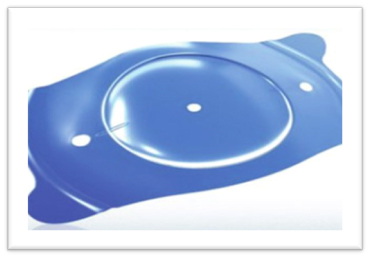

A phakic intraocular lens (IOL) is a special kind of intraocular lens that is implanted surgically into the eye to correct myopia (nearsightedness)and hypermetropia(long sightedness). Practically one can treat the eyes with spectacle power of +10.00 to -30.00 D.
It is called "phakic" (meaning "having a lens") because the eye's natural lens is left untouched. Latest designs of phakic IOLs available, are the most suitable, to the patients.
Phakic IOL (intraocular lenses) are an alternative to LASIK and PRK eye surgery for correcting moderate to severe myopia (nearsightedness), and in some cases produce better and more predictable vision outcomes than laser refractive surgery. Phakic IOLs are clear implantable lenses that are surgically placed just behind the iris, without removing your natural lens.
Phakic lenses enable light to focus properly on the retina for clearer vision without corrective eyewear. Implantable lenses function like contact lenses to correct nearsightedness. The difference is that phakic IOLs work from within your eye instead of sitting on the surface of your eye. Also, phakic IOLs offer a permanent correction of myopia, unless the lens is surgically removed. Unlike contact lenses, you can't feel a phakic intraocular lens in your eye (much like you don't feel a dental filling for a cavity) and, apart from regular eye exams, phakic IOLs typically do not require any maintenance.
What to Consider
Are You A Candidate For Phakic IOLs?
Not all patients are candidates for phakic intraocular lens implantation, just like not all patients are candidates for LASIK.
Some questions to help determine whether phakic IOLs are right for you include:
- Is your spectacle power within the range for which the phakic IOL are available (+10 D to -30D)?
- Have you had a comprehensive eye exam to determine that your eye can safely accommodate an implantable lens? Of particular importance is the depth of the of your eye and the health of the corneal endothelium.
- Are you between the ages of 21 and 40? Even if you are outside this age range, you may still be a candidate for a phakic IOL and should discuss it with your eye surgeon. While a phakic IOL does not treat blurry near vision due to presbyopia, a normal age-related condition that generally starts in your early 40s, monovision IOL surgery can reduce your need for reading glasses.
- Has your eyeglass or contact lens prescription changed in the past year? For vision correction surgeries, you must have had stable vision for at least a year.
- Are your eyes healthy? Conditions such as cataracts, glaucoma, and untreated eye infections generally will prevent you from having a phakic IOL.
- Are you in good health? Certain degenerative or autoimmune diseases such as Sjogren's syndrome, rheumatoid arthritis, type 1 diabetes, HIV and AIDS, as well as certain medications such as steroids and immunosuppressants may interfere with healing and final outcomes.
- Will the cost of phakic IOLs — from pre-screening to ongoing regular check-ups — be covered by your vision insurance?
Phakic IOLs
What To Expect?
- Before:If you wear contact lenses, you should stop wearing them at least one week before your preoperative eye exam and/or consultation. Contacts can alter the shape of your cornea and therefore make your refractive error reading less accurate.
- During: Numbing eye drops are first applied to your eye to alleviate any discomfort The phakic IOL procedure typically takes 10 to 30 minutes . Your surgeon will prescribe antibiotic and anti-inflammatory drops for you to use at home.
- After: Most people notice improved vision immediately following the phakic IOL procedure, but vision may be hazy or blurry with an increased sensitivity to light for the first few days. For some people, it can take two to four weeks for their vision to stabilize.
Vision with the ICL/IPCL tends to stabilize in about one to seven days. There typically is minimal discomfort after phakic IOL surgery but you may have a mild scratching sensation, like something is in your eye. If required, your doctor can prescribe medication to make you more comfortable during the first few days following surgery.
You will need to return for a follow-up visit with your doctor the next day. It's essential that you follow your eye surgeon's post-operative instructions carefully and attend frequent check-ups to help avoid any complications.
Refrain from rubbing or squeezing your eye, lifting heavy objects and participating in strenuous activities until your eye has completely healed, which could take several weeks.
Most people can return to work and resume driving within a couple of days, once you are given the okay from your doctor. Few surgeons prefer to operate both eyes on the same day, few surgeons not. In K K Hospital a gap of 3-7 days between two surgeries is preferred.
Advantages of Phakic lens ( IPCL/ICL)
- High quality of vision.
- Retains corneal asphericity.
- Almost all levels of power can be treated In comparison to other refractive procedures, the ICL/IPCL offers the widest treatment range for correction of vision.
- Can be removed or replaced.
- Fast recovery
- No dry eye
Phakic IOLs vs. LASIK Eye Surgery LASIK currently is the most popular type of refractive surgery . It is safe and effective, and technology advances such as custom LASIK and bladeless LASIK have made visual outcomes even better. But not everyone is a good candidate for LASIK surgery. Potential reasons for not being a good LASIK candidate include: having too much nearsightedness( number above -8.00 ), farsightedness or astigmatism; having an unusually thin or irregularly shaped cornea; and having eye conditions such as keratoconus or dry eye syndrome.
The Phakic IOL in India is a posterior chamber phakic IOL, meaning it is positioned behind the iris and in front of your natural lens. It corrects myopia/nearsightedness ranging from -3.00 to -20.00 D. The ICL/IPCL is made of a soft, biocompatible collagen copolymer. Due to its flexibility, the lens can be folded during implantation, requiring only a small surgical incision.


Potential risks of Phakic lens (ICL / IPCL)?
- Overcorrection
- Undercorrection
- Infection
- Increased Intraocular Pressure
- Damage to Crystalline Lens
- Cataract Development
- Retinal Detachment
- Removal of ICL/IPCL
This complication occurs if the prescriptive power of the implanted ICL/IPCL is too strong. In most cases it can be corrected with corrective eyewear or with an ICL/IPCL replacement.
The opposite of overcorrection, undercorrection is the result of an implantable contact lens with too weak of a prescription. Correction methods are similar to those of overcorrection.
During most surgeries, there is a potential risk of an infection though is it is very less in good surgical set ups.
Pressure may build in the eye after an ICL/IPCL procedure. The sooner a surgeon is alerted to this, the greater the chance of avoiding serious damage. This is detected during your follow up visits with us or in case you face acute blurring of vision or headaches, you must visit the eye clinic. ICL/IPCL may rarely need to be repositioned.
This lens has unique properties of multifocality as well as toricity. It offers minimal dependence on glasses to patients who have pre-existing corneal astigmatism, thus allowing a full range of distance, intermediate, and near vision Your doctor will suggest which IOL is suitable for your eye condition and your visual requirement.
Most of the population will develop cataracts by the age of 65, however, it is believed that the use of phakic iol may cause cataracts at an earlier age, this however is rare.
High Myopic patients are already at high risk of Retinal Detachment. Less than 1 percent of patients in the clinical studies were affected by retinal detachment. It should be noted, however, that the occurrence of retinal detachment increased as the degree of myopia increased.
Phakic lenses are intended to be permanent. Once inplanted it is in eye for life. But if the situation arises it can be removed from the eye.
Key note
Phakic IOLs are an effective option for people with moderate to severe nearsightedness and longsightedness,who fall outside the treatment range of LASIK. The range of correction is spectacle number of +10.00 D to -30.00 D. When considering implantable lenses — or any refractive surgery — be sure to discuss all the benefits and risks with your eye surgeon.


